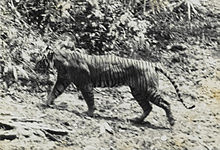Tigers are essentially solitary and territorial animals. The size of a tiger's home range mainly depends on prey abundance, and, in the case of male tigers, on access to females. A tigress may have a territory of 20
square kilometres, while the territories of males are much larger, covering 60–100 km
2. The range of a male tends to overlap those of several females.

Tigers for the most part are
solitaryanimals.
The relationships between individuals can be quite complex, and it appears that there is no set "rule" that tigers follow with regards to territorial rights and infringing territories. For instance, although for the most part tigers avoid each other, both male and female tigers have been documented sharing kills. George Schaller observed a male tiger share a kill with two females and four cubs. Females are often reluctant to let males near their cubs, but Schaller saw that these females made no effort to protect or keep their cubs from the male, suggesting that the male might have been the father of the cubs. In contrast to male lions, male tigers will allow the females and cubs to feed on the kill first. Furthermore, tigers seem to behave relatively amicably when sharing kills, in contrast to lions, which tend to squabble and fight. Unrelated tigers have also been observed feeding on prey together. The following quotation is from Stephen Mills' book Tiger, as he describes an event witnessed by Valmik Thapar and Fateh Singh Rathore in Ranthambhore:
A dominant tigress they called Padmini killed a 250 kg (550-lb) male nilgai – a very large antelope. They found her at the kill just after dawn with her three 14-month-old cubs and they watched uninterrupted for the next ten hours. During this period the family was joined by two adult females and one adult male – all offspring from Padmini's previous litters and by two unrelated tigers, one female the other unidentified. By three o'clock there were no fewer than nine tigers round the kill.
When young female tigers first establish a territory, they tend to do so fairly close to their mother's area. The overlap between the female and her mother's territory tends to wane with increasing time. Males, however, wander further than their female counterparts, and set out at a younger age to mark out their own area. A young male will acquire territory either by seeking out a range devoid of other male tigers, or by living as a transient in another male's territory until he is old and strong enough to challenge the resident male. The highest mortality rate (30–35% per year) amongst adult tigers occurs for young male tigers who have just left their natal area, seeking out territories of their own.

Tiger dentition(above), compared with that of an
Asian black bear (below). The large canines are used to make the killing bite, but they tear meat when feeding using the carnassial teeth.
Male tigers are generally more intolerant of other males within their territory than females are of other females. For the most part, however, territorial disputes are usually solved by displays of intimidation, rather than outright aggression. Several such incidents have been observed, in which the subordinate tiger yielded defeat by rolling onto its back, showing its belly in a submissive posture. Once dominance has been established, a male may actually tolerate a subordinate within his range, as long as they do not live in too close quarters. The most violent disputes tend to occur between two males when a female is in
oestrus, and may result in the death of one of the males, although this is a rare occurrence.
To identify his territory, the male marks trees by
spraying of urine and anal gland secretions, as well as marking trails with
scat. Males show a grimacing face, called the
Flehmen response, when identifying a female's reproductive condition by sniffing their urine markings. Like the other
Panthera cats, tigers can
roar. Tigers will roar for both aggressive and non-aggressive reasons. Other tiger vocal communications include moans, hisses, growls and
chuffs.
Tigers have been studied in the wild using a variety of techniques. The populations of tigers were estimated in the past using plaster casts of their
pugmarks. This method was found faulty and attempts were made to use camera trapping instead. Newer techniques based on
DNA from their scat are also being evaluated. Radio collaring has also been a popular approach to tracking them for study in the wild.












